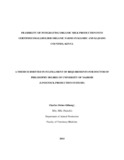| dc.description.abstract | Organic livestock production can be considered as a system of production that better fulfils
animal needs, promotes use of organic and biodegradable input for production and reduce the use
of conventional veterinary treatments. As demand for organic dairy products increases in Kenya,
especially in Nairobi, so does the need to supply the growing demand. Increased diversification
of organic production is needed to meet the growing demand. The objective of this study was
therefore to investigate the potential, challenges and feasibility of integrating organic milk
production in smallholder crop-livestock farms in Kiambu and Kajiado counties of Kenya and
validate the efficacy of Tephrosia vogelii Hook., Tephrosia villosa Pers., and Carica papaya
Linn. leaves and Carica papaya Linn. against gastrointestinal nematodes. Data was obtained
through purposive cross-sectional survey of 55 certified organic crop producers with dairy cattle.
It was complemented with additional information from longitudinal and targeted semi-structured
interviews from 24 farmers randomly selected from previous cross-sectional survey. A
laboratory experiment was also conducted to validate the efficacy of crude aqueous plant extracts
(Tephrosia vogelii Hook., Tephrosia villosa Pers., and Carica papaya Linn. leaves and Carica
papaya Linn.). Result from the study showed that lack of organic inputs to control pest and
diseases (78%) and lack of organic feed (64%) were the most important constraints for farmers
to integrate organic dairy production. The average herd size was 3.53 with all the dairy cows
were zero-grazed. Most of the cubicles were less than 2.50M2(75%) and majority of the farmers
used acaricides on a weekly basis to control ticks (47%), while all incidences of diseases were
treated by a veterinarian. Dried and poultice paste of T. vogelii leaves and C. papaya seeds had
more than 95.8% and 98% reduction in egg hatch
Egg hatch assay revealed more than 95.8% reduction in egg hatch at concentration of 500 mg/ml
for dried and poultice paste of T. vogelii leaves and C.papaya seeds. Larval development
inhibition assay results showed that both dried and poultice paste of T. vogelii leaves and
C.papaya seeds extract yielded more than 98% inhibition at a concentrations of 500mg/ml. respectively.
Based on the LD50 dried extract of C. papaya seeds was most potent extracts for the inhibition of
both egg hatching (49.94mg/ml) and larval development (49.32mg/ml). Integration of organic
dairy production in smallholder farming systems requires sufficient organic feed for cows,
organic inputs to control pest and diseases, re-construction of animal structures and additional
land for regular outdoor run to meet the welfare needs of the cows. Prospects for conversion of
smallholder farming systems to organic dairy production will partly depend upon availability of
research based advice on the use of appropriate robust breeds, development of organic feed
production strategy to supply smallholder farmers, availability of pest and disease control input
under local conditions, the ability of the farmers to make structural adjustments on the cow
housing and allocate more land to the dairy enterprise. Capacity building on the basic
requirements for organic dairy production is essential to ensure that interested farmers make the
necessary adjustments to integrate their enterprises | en_US |

